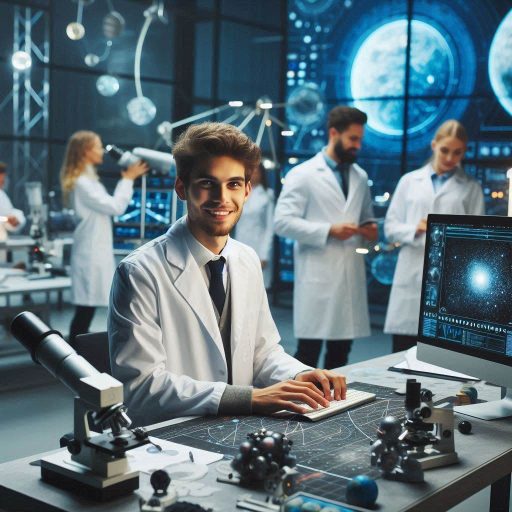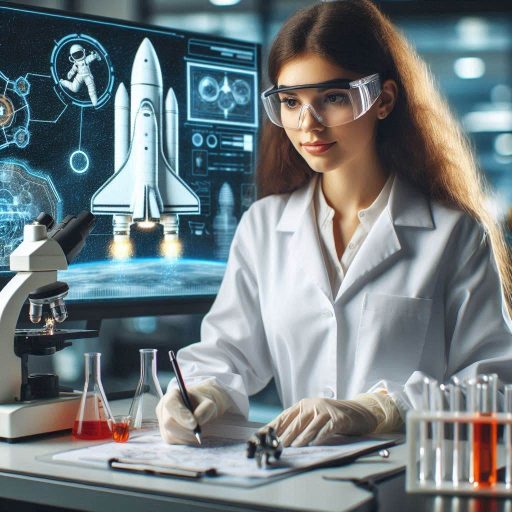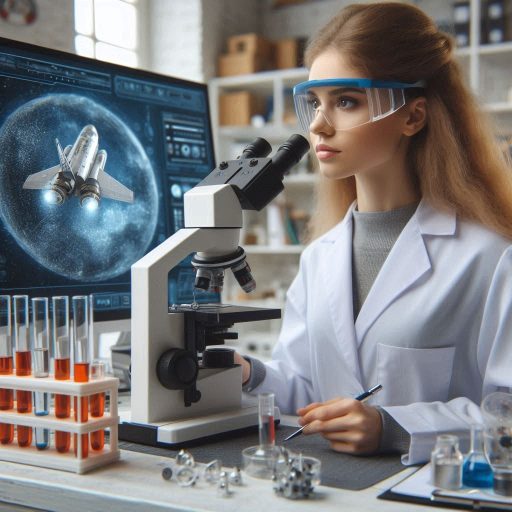Introduction
Astronauts may be the face of space missions, but space scientists are the brains behind the operation.
Their expertise and critical thinking skills are invaluable in planning successful space missions.
Space scientists play a crucial role in every stage of space mission planning, from conceptualization to execution.
They are responsible for designing experiments, analyzing data, and ensuring the safety of astronauts.
One of the key contributions of space scientists to space missions is their ability to anticipate potential challenges and develop contingency plans.
By using their knowledge of space environments and technology, they can make informed decisions that increase the likelihood of mission success.
Furthermore, space scientists collaborate with engineers, mathematicians, and other experts to optimize mission parameters such as spacecraft trajectory, payload design, and communication systems.
Their interdisciplinary approach ensures that missions are both scientifically rigorous and technically feasible.
In addition, space scientists are often involved in post-mission analysis to evaluate the effectiveness of mission strategies and improve future missions.
Their insights help refine techniques, develop new technologies, and expand our understanding of the universe.
Therefore, space scientists are essential for the success of space missions.
Their specialized knowledge, problem-solving skills, and dedication to exploration make them invaluable assets in planning and executing missions beyond the bounds of Earth.
Roles and Responsibilities of Space Scientists in Mission Planning
Researching and Developing New Technologies
Space scientists focus on researching and developing new technologies for space exploration.
They identify gaps in existing technologies and propose innovative solutions.
For example, they may develop advanced propulsion systems to improve spacecraft efficiency.
Their research often involves collaborating with academic institutions and industry partners.
This collaboration fosters innovation and leads to breakthroughs in space technology.
Moreover, space scientists conduct experiments to test new materials and systems.
They explore how these technologies perform in extreme conditions found in space.
Understanding these factors is critical for ensuring equipment reliability during missions.
By evaluating prototypes, they provide valuable feedback to engineers.
Additionally, space scientists investigate the biological impacts of space travel on humans.
They study how microgravity affects the human body and develop countermeasures.
This research is crucial for long-duration missions, such as those to Mars.
It helps ensure the health and safety of astronauts during their journeys.
Analyzing Data and Making Informed Decisions
Space scientists analyze vast amounts of data gathered from previous missions and experiments.
They utilize sophisticated software and algorithms to interpret this data accurately.
By understanding patterns and trends, they make informed decisions about mission planning.
Data analysis allows scientists to identify potential risks and challenges.
They evaluate factors such as orbital mechanics, atmospheric conditions, and radiation levels.
This information guides mission planners in determining the best launch windows and trajectories.
Furthermore, data analysis helps scientists assess the feasibility of mission objectives.
For example, they may analyze the surface conditions of a target planet before landing.
This evaluation informs the selection of landing sites and mission goals.
Collaborating with Engineers and Astronauts
Collaboration is key in space mission planning.
Space scientists work closely with engineers to ensure that technical specifications are met.
They provide insights into scientific requirements, which helps engineers design appropriate systems.
Additionally, space scientists collaborate with astronauts to understand their needs and experiences.
By incorporating astronaut feedback, scientists can improve mission planning and execution.
This partnership helps enhance the overall mission experience and ensures safety protocols are in place.
Effective communication between space scientists, engineers, and astronauts fosters a unified approach to mission planning.
Team members share their expertise and insights, leading to innovative solutions.
Together, they address challenges and enhance mission success.
In general, space scientists are integral to space mission planning.
Their responsibilities include researching and developing new technologies, analyzing data, and collaborating with engineers and astronauts.
By fulfilling these roles, they contribute to the success of space exploration.
Their work paves the way for future missions and expands our understanding of the universe.
Read: Top Skills Needed for a Successful Geology Career
Importance of understanding the challenges and risks of space exploration
Space exploration is a daunting task that requires meticulous planning and preparation to overcome a multitude of challenges and risks.
Space scientists play a crucial role in this process by assessing potential hazards and developing innovative solutions to mitigate them.
Assessing Potential Hazards
Space scientists are tasked with identifying and evaluating the various dangers that astronauts may encounter during a space mission.
These hazards can range from mechanical malfunctions in spacecraft to adverse effects on the human body due to prolonged exposure to microgravity.
By conducting thorough risk assessments, space scientists can anticipate potential problems and devise strategies to prevent or counteract them.
For example, they may design redundant systems in spacecraft to ensure that critical functions can continue even if one component fails.
Furthermore, space scientists must also consider external factors such as cosmic radiation, micrometeoroids, and extreme temperatures that could pose risks to both astronauts and equipment.
Understanding these hazards allows them to develop protective measures like shielding materials or insulation to safeguard the mission’s success.
Developing Solutions
Once potential hazards have been identified, space scientists collaborate with engineers and mission planners to develop effective solutions.
This may involve designing new technologies or modifying existing systems to enhance the safety and reliability of spacecraft.
For instance, in response to the threat of radiation exposure in deep space missions, scientists are researching ways to create more robust shielding materials that can minimize astronauts’ risk of radiation-related illnesses.
Similarly, advancements in life support systems are continually being made to ensure astronauts have access to clean air and water throughout their journey.
Moreover, space scientists work on innovations like autonomous navigation systems and artificial intelligence to enable spacecraft to make rapid decisions in emergency situations.
These technological developments are essential for ensuring the success of space missions by reducing human error and enhancing overall mission efficiency.
Basically, understanding the challenges and risks of space exploration is crucial for the safety and success of missions.
Space scientists play a pivotal role in this process by assessing potential hazards and developing solutions that prioritize the well-being of astronauts and the overall mission objectives.
Read: The Future of Botany: Emerging Fields and Innovations
Utilizing simulation and modeling techniques in mission planning
Creating Realistic Scenarios to Test Mission Strategies
To begin, space scientists create realistic scenarios that simulate mission conditions.
These scenarios account for various factors, including environmental conditions, spacecraft behavior, and crew dynamics.
Scientists use advanced computer models and simulations to design these scenarios.
They replicate potential challenges astronauts may face during the mission.
Testing mission strategies in simulated environments allows teams to evaluate their effectiveness.
This process helps identify strengths and weaknesses in proposed strategies.
By running multiple simulations, scientists can gather data on various mission aspects.
These data help refine strategies and enhance mission success rates.
Additionally, conducting these tests provides opportunities for training.
Crew members can practice their roles in a controlled environment.
They learn how to respond to various situations, improving their preparedness.
Well-prepared astronauts are crucial for managing unforeseen challenges in space.
Identifying Potential Issues and Making Necessary Adjustments
Another vital responsibility of space scientists is identifying potential issues early in the planning process.
They analyze data from simulations and real-world missions to spot potential risks.
This proactive approach helps prevent costly errors during the actual mission.
By understanding possible challenges, scientists can adjust mission plans accordingly.
For example, if simulations reveal a flaw in the spacecraft‘s navigation system, scientists can address it before launch.
They collaborate with engineers to redesign or modify components.
This collaboration ensures that all systems function optimally during the mission.
Moreover, identifying issues extends beyond technology.
Space scientists also consider human factors that can impact mission success.
They analyze crew dynamics, psychological resilience, and team communication.
This analysis informs strategies to foster collaboration and teamwork among crew members.
Making necessary adjustments based on identified issues strengthens mission planning.
It also builds confidence in the mission‘s overall success.
By thoroughly examining every aspect of the mission, scientists ensure all scenarios are accounted for.
Generally, space scientists are vital to space mission planning.
Their work in creating realistic scenarios and identifying potential issues ensures thorough preparation.
By testing mission strategies, they enhance the likelihood of successful outcomes.
Furthermore, their ability to make necessary adjustments is crucial in addressing challenges.
Through their efforts, space scientists help pave the way for future explorations, pushing the boundaries of our understanding of the universe.
Their expertise ultimately contributes to the safety and success of astronauts venturing into space.
Read: What Does a Geologist Do? Career Overview and Insights

Collaborating with international partners in space missions
Working with Scientists from Different Countries
Working with international scientists enhances the quality of space missions.
Each country contributes unique knowledge and technology.
For instance, the United States may offer advanced robotics, while European nations excel in satellite technology.
This combination of strengths fosters innovation.
Collaboration allows scientists to exchange ideas and best practices.
They hold joint workshops, conferences, and meetings to share insights.
Such interactions facilitate networking and build trust among team members.
This environment encourages open communication, essential for effective collaboration.
Moreover, diverse perspectives lead to more comprehensive mission plans.
Scientists from different backgrounds can identify potential challenges and opportunities.
This insight improves problem-solving and decision-making throughout the planning process.
By working together, they create more resilient mission strategies.
Sharing Expertise and Resources to Achieve Common Goals
Sharing expertise and resources is vital for successful space missions.
Each participating country often has specialized knowledge that can enhance mission outcomes.
For example, one country may excel in deep-space navigation, while another may specialize in data analysis.
By pooling their expertise, they maximize the potential for mission success.
Resource sharing also includes funding, technology, and equipment.
Joint missions often lead to cost savings, as countries share expenses.
This collaboration allows for more ambitious projects that would be difficult for a single nation to undertake.
Furthermore, shared resources improve research and development efforts.
When scientists collaborate, they can access advanced technologies and methodologies.
This access accelerates the pace of innovation, enabling teams to tackle complex challenges.
International collaboration fosters a sense of unity and shared purpose.
Scientists work toward a common goal: advancing human understanding of space.
This collective ambition transcends national boundaries and encourages global cooperation.
Additionally, shared successes inspire future collaborations.
When missions achieve their objectives, they pave the way for new projects.
This momentum fuels ongoing partnerships among countries and scientific communities.
Read: Educational Path: Becoming a Geologist in the USA
Transform Your Career Today
Unlock a personalized career strategy that drives real results. Get tailored advice and a roadmap designed just for you.
Start NowLearn More: Field Equipment Essentials for Aspiring Ecologists
Incorporating scientific research goals into mission objectives
Conducting Experiments and Collecting Data in Space
Space missions provide unique opportunities to conduct experiments that cannot be performed on Earth.
Microgravity environments allow scientists to study physical and biological processes in new ways.
For example, scientists can observe fluid dynamics without the interference of gravity.
This research contributes valuable insights into fundamental scientific questions.
In addition, space missions enable scientists to collect data from distant celestial bodies.
Instruments aboard spacecraft measure a variety of factors, including temperature, radiation, and chemical composition.
This data is vital for understanding the characteristics of planets, moons, and asteroids.
It also helps scientists assess the potential for life beyond Earth.
Space scientists collaborate with engineers to design and build specialized instruments for these missions.
These instruments must withstand harsh conditions and operate reliably in space.
Successful data collection depends on meticulous planning and testing of these instruments.
Scientists ensure that each mission aligns with scientific goals while maintaining safety and efficiency.
Moreover, space missions often involve international collaboration among scientists from various countries.
This collaboration fosters the exchange of ideas and expertise, leading to more comprehensive research outcomes.
By working together, scientists can tackle complex questions that span multiple disciplines.
Such teamwork enhances the scientific community’s ability to address pressing issues related to space exploration.
Advancing Our Understanding of the Universe and Our Place in It
The data collected during space missions advances our understanding of the universe.
Each mission uncovers new information about the origins and evolution of celestial bodies.
For instance, missions to Mars have revealed evidence of ancient water, suggesting the planet once harbored conditions suitable for life.
This knowledge reshapes our understanding of where life might exist beyond Earth.
Additionally, space scientists study cosmic phenomena such as black holes, supernovae, and dark matter.
Their research helps unravel the mysteries of the universe and our place within it.
By understanding the forces that govern the cosmos, we gain insights into the fundamental laws of nature.
Furthermore, space missions inspire future generations to explore careers in science and engineering.
The excitement of discovering new worlds and phenomena captivates young minds.
This enthusiasm drives educational initiatives that promote STEM fields, ensuring a bright future for scientific exploration.
Balancing scientific objectives with practical considerations
Ensuring That Mission Goals Align with Budget Constraints
Space missions often require substantial funding.
Scientists must work within financial limits while maximizing scientific return.
They assess the costs associated with various mission components.
This includes spacecraft design, instruments, and operational expenses.
By understanding budget constraints, they prioritize essential mission elements.
Space scientists collaborate with engineers and financial analysts.
They develop detailed project budgets that reflect realistic goals.
This collaboration ensures that all aspects of the mission receive adequate resources.
During the planning phase, they conduct cost-benefit analyses to identify the most efficient use of funds.
By weighing scientific objectives against budgetary realities, scientists help avoid costly overruns.
Budget constraints often necessitate creative problem-solving.
Scientists explore innovative approaches to meet mission goals within financial limits.
For example, they might use existing technology instead of developing new instruments.
This strategy can reduce costs while still achieving significant scientific results.
They also consider partnerships with other organizations to share costs and resources.
Making Trade-Offs Between Scientific Value and Mission Feasibility
Space scientists must frequently make trade-offs between scientific value and mission feasibility.
Each mission has specific goals, but these goals must be achievable.
Scientists evaluate whether ambitious objectives can be realistically met.
If goals exceed current capabilities, they may need to be adjusted.
Feasibility assessments consider various factors.
Technical challenges, timelines, and risk levels all play a role.
Scientists analyze these factors to determine the best course of action.
They often face the dilemma of choosing between groundbreaking science and practical execution.
This requires careful consideration and collaboration among team members.
Scientists strive to balance ambitious scientific goals with realistic mission parameters.
They may propose alternative mission designs that still meet essential objectives.
This flexibility allows for innovative solutions while adhering to constraints.
For example, they might suggest a smaller spacecraft that can still gather vital data.
Engaging with stakeholders is also essential in this process.
Space scientists communicate mission plans and adjustments to funding agencies.
They explain the reasoning behind trade-offs to maintain support and funding.
Clear communication fosters trust and understanding among all parties involved.
Ultimately, space scientists play a vital role in space mission planning.
They ensure that mission goals align with budget constraints and make necessary trade-offs.
By balancing scientific value with feasibility, they contribute to successful missions.
Their expertise and collaboration with other professionals lead to innovative solutions and impactful research.
Ultimately, space scientists help pave the way for future discoveries in the vast universe.
Conclusion
Space scientists play an essential role in space mission planning, contributing their expertise across various scientific disciplines.
They analyze vast amounts of data from previous missions and telescopes, helping to identify potential targets for exploration.
Their knowledge informs mission objectives and guides the development of experiments designed to answer critical questions about our universe.
By formulating hypotheses and outlining scientific goals, space scientists ensure that missions are focused and productive.
The collaborative nature of space exploration is vital for mission success.
Interdisciplinary teamwork brings together engineers, astronomers, planetary scientists, and other specialists to tackle complex challenges.
Each team member offers unique perspectives and skills, fostering innovative solutions to problems that arise during planning and execution.
For example, engineers design spacecraft capable of withstanding harsh space conditions, while scientists ensure that the instruments onboard can effectively gather and analyze data.
Effective communication among team members enhances the overall mission strategy, ensuring that every aspect is carefully considered.
Regular meetings and updates help maintain alignment and address any emerging issues promptly.
By working together, space scientists and their colleagues maximize the potential for groundbreaking discoveries, making each mission a comprehensive effort.
[E-Books for Sale]
The Big Book of 500 High-Paying Jobs in America: Unlock Your Earning Potential
$19.99 • 500 High-Paying Jobs • 330 pages
Explore 500 high-paying jobs in America and learn how to boost your career, earn more, and achieve success!
See All 500 High-Paying Jobs of this E-Book
1001 Professions Without a Degree: High-Paying American Jobs You Can Start Now
$19.99 • 1001 Professions Without a Degree • 174 pages
Discover 1001 high-paying jobs without a degree! Unlock career tips, skills, and success strategies for just $19.99!




